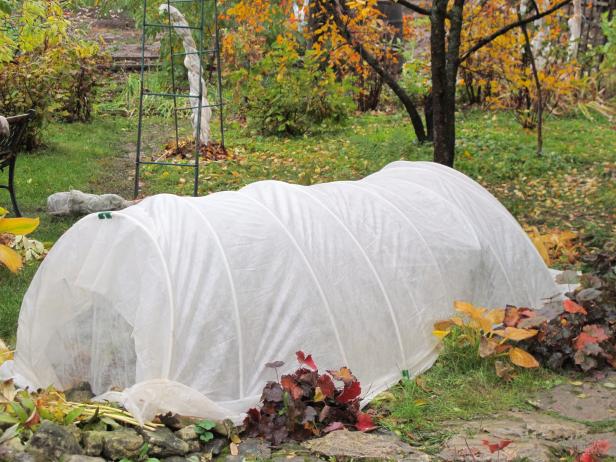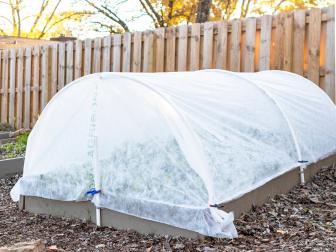Plant Covers for Winter
Discover how to use row covers to protect your plants from frost and extend the growing season.

Shutterstock/photowind
Keep your plants safe from frost by using winter plant covers. These chill-chasing covers give plants a cozy hideaway that’s warmer than surrounding air. The difference is often only a few degrees, but those degrees make a big difference.
Protecting plants from freezes isn’t difficult. One of the most common winter plant covers is a floating row cover that you toss over plants before a freeze arrives. These row covers work by excluding cold air and creating an insulating air pocket around plants. Heat from soil, which is warmer than air, is trapped beneath the cover and held near plants.
These cold-defeating fabrics are made from a woven polypropylene that’s lightweight and breathable. The material allows sunlight and water to reach plants, but keeps frost out. Most of these winter row covers are also UV-stabilized. This means the materials won’t break down quickly when exposed to sunlight and can be used for several growing seasons.
Winter Gardening Don'ts 21 Photos
Protect your garden this winter by avoiding common mistakes that put plantings at risk.
Floating row covers for frost protection (also referred to as frost blankets) come in varying thicknesses. Thicker covers protect plants to a greater degree than thinner ones. Thicker row covers also exclude more light. Thinner covers typically protect plants to 28 degrees and permit 70 percent of sunlight to reach plants, while thicker covers protect plants from 24 to 26 degrees and allow 30 percent of sunlight to reach plants. It's most economical to purchase row cover rolls 20 to 100 feet long, 6 or 12 feet wide. Cut the fabric into custom sizes, and sew pieces together as needed to form larger blankets.
Although floating row covers can lie directly on plants, you’ll get the best protection when you create a framework that holds the winter row covers above plants. Doing this will prevent damage to plants after a heavy rain, frost or snow that will weigh the fabric down.
To suspend the row cover above your plants, build a temporary or permanent framework for the row cover using flexible PVC pipes slid over pieces of rebar driven into the ground. Or, drape the blanket over short wire garden fencing. Using materials you have on hand is the secret to creating an inexpensive support system.
How to Build a Hoop House to Protect Your Vegetables
Extend your cool-weather growing season and even get a jump on spring with a DIY hoop house frame to cover a raised bed.
When using a floating row cover, be sure to anchor the edges to exclude all cold air. Hold edges down with landscape pins, bricks, lumber or other available materials. Or bury edges in a shallow trench, anchoring them with soil.
Other Plant Covers
If you prefer to use sheets of plastic to cover your plants, you’ll need to provide ventilation by cutting slits in the plastic, rolling up the edges or removing the cover as temperatures rise. Heat can build up under plastic, killing or damaging the plants it’s supposed to be protecting. If you use black plastic as a temporary row cover, remove it when temperatures edge out of the danger zone so light can reach plants.
You can also find winter plant covers specifically designed to slip over hanging baskets and container plantings. Drawstrings with cord locks allow you to cinch the cover closed. Like other frost blankets, these covers come in various sizes and thicknesses.
Row Covers Are Not Just for Winter
Row covers for winter prove invaluable on both ends of the growing season. Use them in early spring to protect newly planted seedlings from late-season frosts or to give them a toasty mini-greenhouse atmosphere as they establish. Use them in summer to protect plants from insect pests. And in fall, use floating row covers to get plants through an early cold snap or to create a frost-free growing environment to extend the garden season.
















































